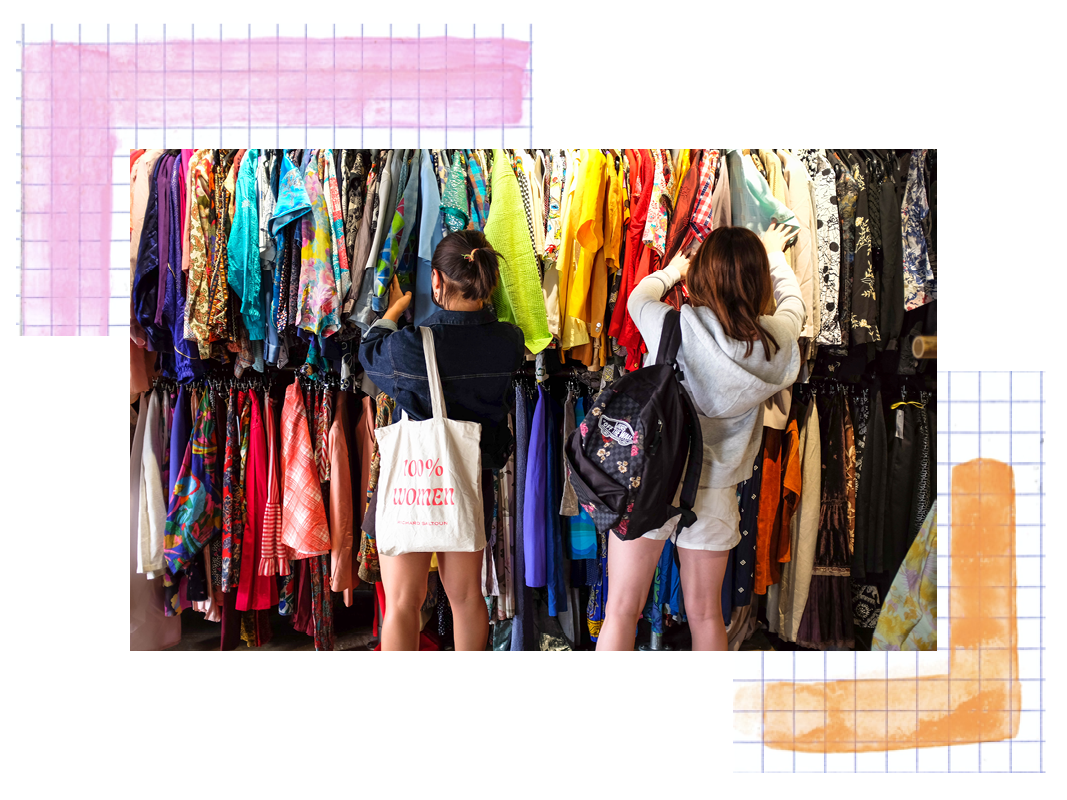From the first week I moved to London, I’ve been obsessed with its plethora of charity shops. But one has always stood out: trendy, not too pretentious, cheap, cheerful, and filled to the brim with treasures. I rarely step out without a new gem (most recently, a pair of tomato-red vintage trousers).
I’m not alone in my devotion. It’s been a fixture across London for over 20 years, with 13 branches spread out across the capital, and you’ll find it listed on virtually every round up of the UK’s top charity shops for its wide-ranging selection of quality items. But it also stands out for its mission. TRAID isn’t just fixing fast fashion indirectly by providing a more sustainable way of shopping, but also tackling waste in the industry head-on.
“We’re the only charity that focuses totally on the textile supply chain: so it’s collecting and selling clothes for the environmental benefit, which then funds projects [addressing] how clothes are made,” explained Maria Chenoweth, TRAID’s CEO of 22 years. These include initiatives to improve working conditions and practices in the clothing industry as well as educating people about sustainable fashion.
This feeds into how its stores are stocked, which focuses on reducing waste. Rather than just over-the-counter donations, a network of 1,500 clothes banks across the UK collects around 11,000 items a week to sort and sell. This huge volume is made possible by a central warehouse where all clothes are sent to be sorted, tagged and collected by store managers. Every week, they go to the warehouse and select items for their shop.
“It’s like curating for the different areas,” said Tom, the Brixton shop’s manager. “There is a big conveyor belt of clothes. The manager will sit at the front of the belt and get the first pick of the clothes. It’s like a gameshow, desperately trying to catch things as they go past.
“It’s all handpicked and there’s a reason for everything to be [in the shop], whether the fabric or the design or the label. So you pick up what is quality and designer, but also what’s trendy and what’s more suited to the location.”
The only thing that’s hard to find? “We’re always struggling for men’s clothing, interesting men’s clothes especially,” said Tom. “The way that men use their clothes and the way they shop, which isn’t a bad thing, is that they tend to wear them until they’re dead.”
Once picked, managers bring back their wares to price and tag. Pricing is always difficult, Tom said, because it depends not just on brand but also the fabric and cut. Anyone who really wants to grab a bargain can swing by the legendary (to me, at least) end of season sales, where everything on the shop floor is marked down and prices often start at £2. If an item doesn’t sell in one store, it gets rotated out to another – keeping racks fresh and increasing its chances of selling.
Despite the different stock, every shop, from the well-heeled Westbourne Grove to the ultra-trendy Dalston store, has two striking things in common. First, every item is organised on the racks by colour, creating a vibrant rainbow around the shop.
Second, the incredible windows displays. One day the mannequins will sport retro-futuristic grab in metallic sparkles, the next, Met Gala-ready gowns fashioned from patchwork quilts. It’s all the work of one man, Francesco Colucci. He started as a sales assistant in the Clapham shop. Chenoweth said: “He did a window [display] one day, and it was like, ‘oh my god, Francesco’s windows! You can become the window person.’”
Now, artist duo Gilbert & George are fans, and Colucci was even profiled by Vogue a few years back. For Chenoweth, it shows how “organically” everything happens at TRAID – staff are paid (unlike many charity shops) and stay for an average of 13 years.
Not only did TRAID weather lockdown, it even opened two new shops over the past year and experienced a deluge of donations (but Chenoweth is “dreading” all the donations of loungewear when people get back to the office). To keep stock moving when stores were closed, the team experimented with selling through Depop and eBay. Is the much-criticised practice of people buying up charity shop stock to sell at a mark-up online a problem?
Chenoweth said it isn’t a concern: they are happy for anyone to help reduce waste. “If someone finds something, like a bargain or it’s got a lot of value – then good on them. They’re the person that is going out and doing the hunting, and it’s part of the feel-good factor of secondhand shopping.”
Plus, although young people are making sustainable fashion and secondhand cool again, Chenoweth thinks TRAID reaches a broader demographic than the reselling apps. “Young people, old people – I want anybody to be able to walk into a TRAID shop, and be able to find something to wear second hand,” she said.
“When we reopened our shops, people loved it. I think charity shops on high streets are so healthy. You have all these great interactions. Where I live the people in the charity shops have seen my kids grow up… You don’t get that online.”
Tom’s tips for grabbing a bargain
- Quickly glance through the rail to spot interesting prints, colours or fabrics
- Touch everything – it will help you spot quality fabrics, like cashmere, and vintage items, which will have more weight
- Give yourself time to browse and be open to hidden gems
- Look out for the sales with their steep discounts, but also the big restocks right after them
- Call back often: stock is rotated every three weeks, so there’s always something new

